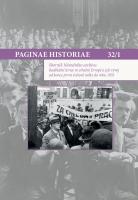Odhodlaní a povolaní. Jan Šverma a jeho přátelé v době V. sjezdu KSČ
Authorised and Determined. Jan Šverma and His Friends at the Time of the Fifth Congress of the Communist Party of Czechoslovakia
Author(s): Jiří KřesťanSubject(s): History, Political history, Recent History (1900 till today), Interwar Period (1920 - 1939), History of Communism
Published by: Národní archiv
Keywords: Šverma Jan; communism; policy; Communist Party of Czechoslovakia
Summary/Abstract: During the Sixth World Congress of the Communist International in the summer of 1928, the leaders decided to support the ‘new left’ group that criticised the leadership of the Communist Party of Czechoslovakia. Klement Gottwald was appointed its respected leader. At the Sixth Congress, the graduates of the International Lenin School in Moscow, including Jan Šverma, further strengthened the group. Stalin and the Comintern leaders were satisfied that young, loyal leaders gained ground in European communist countries and were willing to proceed radically (to escalate class struggles, criticise social democratic political bosses, defend the Soviet Union with resolve, and restructure the party into a military unit). This corresponded to the left turn in the Comintern strategy. Gottwald’s ‘new left’ pushed through the rise to power in a discussion inside the Communists Party of Czechoslovakia, especially its district and regional conferences that elected the delegates to the Fifth Party Congress convened in February 1929. The study reveals that the Comintern leaders did not have absolute support. While Gottwald’s radicals relied on electing a ‘homogeneous’ leadership of the Communist Party of Czechoslovakia at the congress, the Comintern leaders insisted that previous leaders, including the central secretary Bohumil Jílek, remain in the leadership. The author of the study substantiates that prior to the Sixth World Congress of the Communist International, discontentment rose in the communist party, and some young functionaries called for more radical processes. Moreover, they were clamouring for organisational changes inside the party to achieve a better fighting efficiency (building organisations at races). This is further proved by the thesis of the British historians Kevin McDermott and Jeremy Agnew that the bolshevising process of the communist parties was not only dictated by Moscow, but it was also grounded on the unique situations in countries and their group interests. The failure of the demonstration held in Prague on Red Day, 6 July 1928, followed unsuccessful strike fights, failures of the communist negotiations in the parliament, and poorly prepared public manifestations. The dragging conflict inside the party escalated after the failure of Jílek’s Red Day organisation. Using the example of Jan Šverma, the study shows the different motivation behind the support of the radical wing of the Communist Party of Czechoslovakia. Šverma was shaped by his family upbringing and social experience, reading expert literature and fiction, but also by learning about the bourgeois life of Bohumil Jílek and some functionaries. Šverma processed the Comintern documents on his own and analysed his Czechoslovak society experience. Over time, he departed from the tense radicalism he professed in the first half of the 1920s. It opened the door for him to adopt the idea of the cooperation of the anti-fascist powers in the 1930s. His thinking was predominated by the emphasis on the principles of equality and social justice. However, young communists related the enforcement of the new order to the violently enforced vision of communism they imposed on society.
Journal: Paginae Historiae
- Issue Year: 32/2024
- Issue No: 1
- Page Range: 201-222
- Page Count: 22
- Language: Czech

